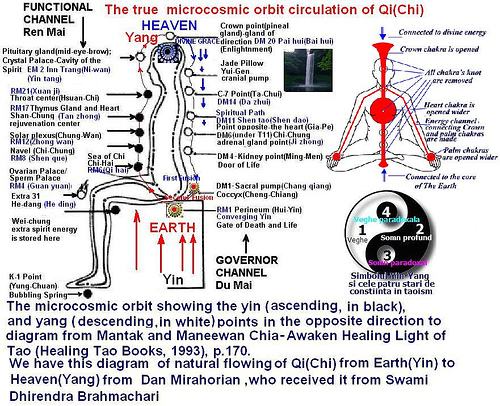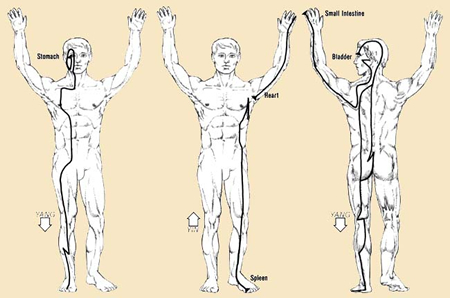A doctor uses acupuncture to treat a patient. body.
Balance within the body depends on the interplay between two
forms of energy, called yin and yang. When these forces are
in harmony, the body is healthy. When either force becomes
dominant, disease or pain occurs. Acupuncture restores the
balance between yin and yang by tapping into the body's channels,
or meridians, through which these energy forms flow.
The ancient Chinese techniques of acupuncture and acupoint therapy
can be used to help heal the body from any illnesses and
also promote general health. If you haven't looked into these
methods of healing, you may want to look into it.
Acupuncture has been used for centuries to provide healing, pain
relief, and relief from other symptoms and illnesses. Traditional
Western medicine experts are beginning to realize that it has
merit and produces results.
East Meets West
Two very different theories exist as to how acupuncture works.
According to Chinese philosophy, the body contains two opposing
forces: yin and yang. When these forces are in balance, the body
is healthy. Energy, called "qi" (pronounced "chee"),
flows like rivers along pathways, or meridians, throughout the
body. This constant flow of energy keeps the yin and yang balanced.
However, the flow of energy can sometimes be blocked, like water
getting stuck behind a dam. A disruption in the flow of energy
can lead to illness.
Diagnosis functions:
Combining the ancient knowledge of Traditional Chinese Medicine
(TCM) with sophisticated electronic circuitry, the Electronic
Acupuncture Pen SR-900B diagnosis therapy can assist user to
diagnose their health condition accurately and find the potential
disease in advance through the acupuncture points on the palm,
all round and easily even at home, which can be considered
as a real "home doctor".
Acupuncture treatment:
By using electric pulses to stimulate acupuncture points deep
beneath the skins, the machine will not sink and hurt human
skins like traditional acupuncture methods using silver needles.
It therefore reduces the fear of punching needles into the
bodies, and also eliminates the danger of bloods and viruses
cross-infections. It is safe to use and dependable. This is
so-called "green treatment" leads to painless and
non-destructive usages which is different form and somtimes
better than traditional needles.

The goal of acupuncture is to establish healthy body function
by restoring the natural circulation of energy, or life force
known in Chinese medicine as Qi. (This is pronounced as "chee" and
is also commonly spelt as ch'i, chi or ki).
Qi is a fundamental concept of everyday Chinese culture, most
often defined as "air" or "breath" and, by
extension, "life force" or "spiritual energy" that
is part of everything that exists.
The pathways through which this vital energy flows are known
as meridians.
What is a Meridian?
Acupuncture vessels, or meridians, are located throughout the
body. They contain a free-flowing, colorless, non-cellular liquid
which may be partly actuated by the heart. These meridians have
been measured and mapped by modern technological methods, electronically,
thermaticly, and radio-actively. With practice, they can also
be felt. There are specific acupuncture points along the meridians.
These points are electro-magnetic in character and consist of
small, oval cells called bonham corpuscles, which surround the
capillaries in the skin, the blood vessels, and the organs throughout
the body. There are some 500 points which are being used most
frequently in a definite sequence, depending on the action desired.
We name meridians by the life function with which they seem to
associate. In most cases, this name is similar to the name of
a gross organ we're familiar with, yet muscle indication of energy
blockage doesn't mean there's damage to the organ named. We cannot
say that a weak muscle means a weak organ - we can only note
that a portion of the meridian energy flow indicates blockage
or constriction.

If you want to experiment a bit, you can probably locate some
of these
points right now. Just apply moderate pressure. If there
is pain, TCM would say that your energy is blocked.
Here
are some acupuncture points:
There is a point on the indentation at the top of your breast
bone.
There are others down the center of your body every few inches.
Your ears also contain many points. You can start at the top
and press/squeeze you ear along the edges right down toyour ear
lobe.
If putting pressure on any of the points results in pain, you
may find that doing a circular motion with moderate pressure
for about 8 turns on the point for several days will 'unblock'
the energy and the point will no longer be painful.

PDF Files for a basic
Understanding
PETS
What conditions are most often treated with acupuncture?
In veterinary medicine, there is evidence of the success of acupuncture
for treating disorders of the reproductive, musculoskeletal,
neurologic, pulmonary, gastrointestinal and dermatologic systems.
The most common conditions that are treated include traumatic
nerve injuries, intervertebral disk disease, degenerative myelopathy,
epilepsy and other central nervous system disorders; asthma,
allergic dermatitis, lick granulomas; and chronic pain such
as that caused by degenerative joint disease.
Acupuncture can be used in conjunction with general anesthesia,
allowing decreased doses of drugs such as analgesics. Any condition
may potentially benefit from acupuncture
The use of acupuncture for treating illnesses and
relieving pain dates back thousands of years in China. Continuous
refining of the process and monitoring the effects of the classic
acupuncture which uses needles was obviously on of the reasons
that this kind of "alternative" became accepted by
western health professionals.
Scientific evidence for the mechanism of action is extensive.
Electro acupuncture was developed many years ago and is being
used successfully worldwide.
The following is
an excerpt from an official WHO document entitled “Acupuncture:
Review and Analysis of Reports on Controlled Clinical Trials.” Compiled
by John A.
Amaro D.C., FIAMA, Dipl.Ac, L.Ac.
Email: DrAmaro@IAMA.edu
Diseases and disorders that have been treated
with acupuncture
The diseases or disorders for which acupuncture therapy has been
tested in controlled clinical trials
reported in the recent literature can be classified into four
categories as shown below.
Diseases, symptoms or conditions for which
acupuncture has been proved—through
controlled trials—to be an effective treatment:
Adverse reactions to radiotherapy and/or chemotherapy
Allergic rhinitis (including hay fever)
Biliary colic
Depression (including depressive neurosis and depression following
stroke)
Dysentery, acute bacillary
Dysmenorrhoea, primary
Epigastralgia, acute (in peptic ulcer, acute and chronic gastritis,
and gastro spasm)
Facial pain (including craniomandibular disorders)
Headache
Hypertension, essential
Hypotension, primary
Induction of labour
Knee pain
Leukopenia
Low back pain
Malposition of fetus, correction of
Morning sickness
Nausea and vomiting
Neck pain
Pain in dentistry (including dental pain and temporomandibular
dysfunction)
Periarthritis of shoulder
Postoperative pain
Renal colic
Rheumatoid arthritis
Sciatica
Sprain
Stroke
Tennis elbow
Diseases, symptoms or conditions for which
the therapeutic effect of acupuncture
has been shown but for which further proof is needed:
Abdominal pain (in acute gastroenteritis or due to
gastrointestinal spasm)
Acne vulgaris
Alcohol dependence and detoxification
Bell’s palsy
Bronchial asthma
Cancer pain
Cardiac neurosis
Cholecystitis, chronic, with acute exacerbation
Cholelithiasis
Competition stress syndrome
Craniocerebral injury, closed
Diabetes mellitus, non-insulin-dependent
Earache
Epidemic haemorrhagic fever
Epistaxis, simple (without generalized or local disease)
Eye pain due to subconjunctival injection
Female infertility
Facial spasm
Female urethral syndrome
Fibromyalgia and fasciitis
Gastrokinetic disturbance
Gouty arthritis
Hepatitis B virus carrier status
Herpes zoster (human (alpha) herpesvirus 3)
Hyperlipaemia
Hypo-ovarianism
Insomnia
Labour pain
Lactation, deficiency
Male sexual dysfunction, non-organic
Ménière disease
Neuralgia, post-herpetic
Neurodermatitis
Obesity
Opium, cocaine and heroin dependence
Osteoarthritis
Pain due to endoscopic examination
Pain in thromboangiitis obliterans
Polycystic ovary syndrome (Stein–Leventhal syndrome)
Postextubation in children
Postoperative convalescence
Premenstrual syndrome
Prostatitis, chronic
Pruritus
Radicular and pseudoradicular pain syndrome
Raynaud syndrome, primary
Recurrent lower urinary-tract infection
Reflex sympathetic dystrophy
Retention of urine, traumatic
Schizophrenia
Sialism, drug-induced
Sjögren syndrome
Sore throat (including tonsillitis)
Spine pain, acute
Stiff neck
Temporomandibular joint dysfunction
Tietze syndrome
Tobacco dependence
Tourette syndrome
Ulcerative colitis, chronic
Urolithiasis
Vascular dementia
Whooping cough (pertussis)
Diseases, symptoms or conditions for which
there are only individual controlled trials
reporting some therapeutic effects, but for which acupuncture
is worth trying
because treatment by conventional and other therapies is difficult:
Chloasma
Choroidopathy, central serous
Colour blindness
Deafness
Hypophrenia
Irritable colon syndrome
Neuropathic bladder in spinal cord injury
Pulmonary heart disease, chronic
Small airway obstruction
Diseases, symptoms or conditions for which
acupuncture may be tried provided the
practitioner has special modern medical knowledge and adequate
monitoring
equipment:
Breathlessness in chronic obstructive pulmonary disease
Coma
Convulsions in infants
Coronary heart disease (angina pectoris)
Diarrhoea in infants and young children
Encephalitis, viral, in children, late stage
Paralysis, progressive bulbar and pseudobulbar
Source |